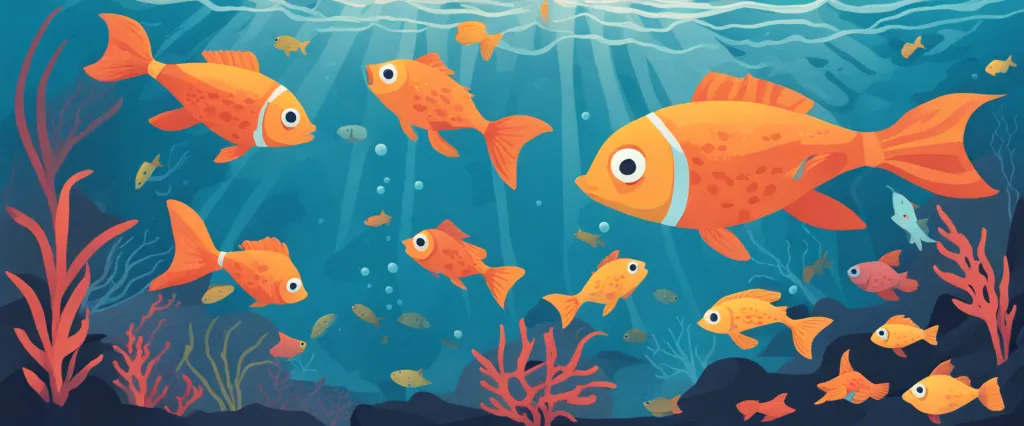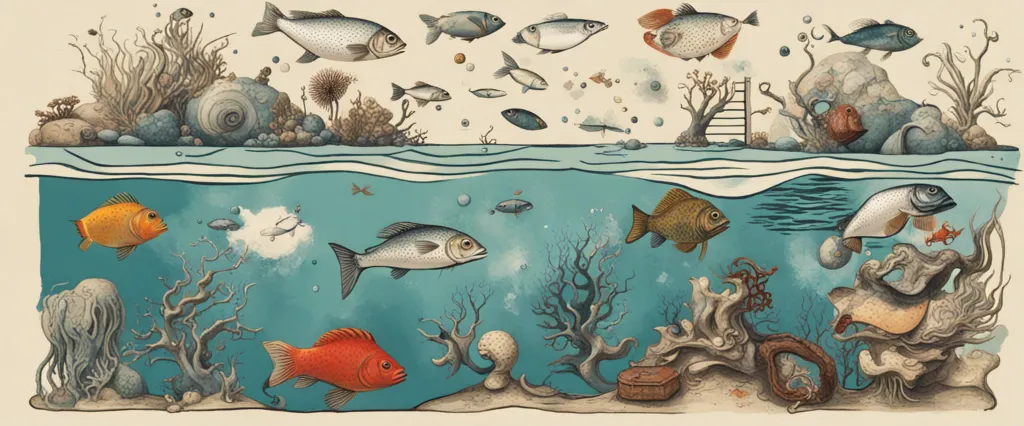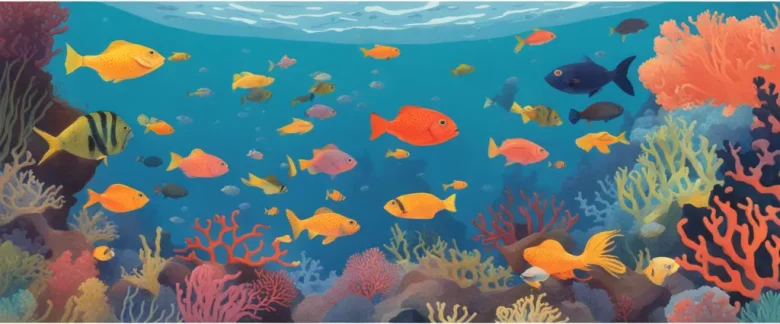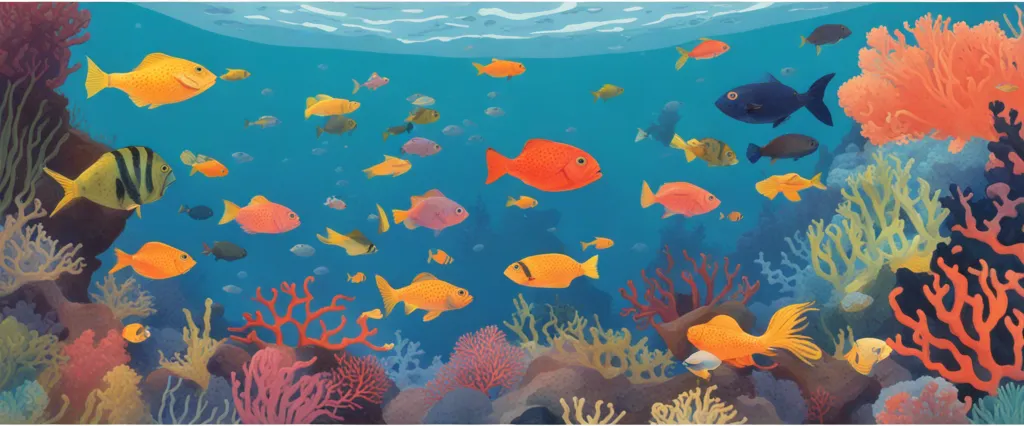In What a Fish Knows, Jonathan Balcombe delves into the underwater world to unravel the mysteries that surround these often underestimated and misunderstood creatures. With astonishing discoveries and captivating anecdotes, Balcombe challenges our perceptions and uncovers the extraordinary lives fish lead. As a renowned ethologist and animal behavior researcher, Jonathan Balcombe has dedicated his career to gaining insights into the lives of diverse species. Through his work, he aims to bridge the gap between scientific knowledge and public understanding, advocating for a deeper appreciation and respect for all living beings.
Chapter 1: Introduction to Fish
Chapter 1: Introduction to Fish from the book “What a Fish Knows” by Jonathan Balcombe provides an insightful overview of the fascinating world of fish. Balcombe challenges the traditional belief that fish are unintelligent creatures with limited capabilities, aiming to shed light on the complexity and intelligence of these aquatic beings.
The chapter begins by highlighting the sheer diversity of fish, with over 30,000 known species inhabiting the world’s waters. Balcombe emphasizes that fish occupy a wide range of habitats, from tropical coral reefs to deep-sea trenches, and have evolved a remarkable array of adaptations to survive and thrive in their respective environments.
Contrary to popular perception, fish possess a variety of cognitive abilities, including memory, learning, and problem-solving skills. Balcombe shares numerous studies and anecdotes that demonstrate fish intelligence, such as their ability to use tools, recognize themselves in mirrors, and communicate with one another through complex vocalizations and body postures.
A major focus of the chapter is debunking the myth that fish have a three-second memory. Balcombe presents evidence to support the idea that fish have a much more sophisticated memory system than previously thought. They can recall past events, learn from their experiences, and retain information for extended periods.
Moreover, Balcombe addresses the issue of fish sentience, focusing on their capacity to experience emotions and pain. Research suggests that fish have individual personalities, form social bonds, and display empathy towards others. He also examines the ethical implications of disregarding fish welfare due to limited public awareness of their cognitive abilities.
Overall, Chapter 1 serves as a captivating introduction to the world of fish, challenging preconceived notions and revealing the remarkable intelligence and sentience of these often underestimated creatures. Balcombe seeks to instill a greater appreciation for fish and promote their well-being in our interactions and treatment of them.
Chapter 2: Sensory Perception
Chapter 2 of “What a Fish Knows” by Jonathan Balcombe delves into the fascinating world of fish sensory perception. Balcombe highlights how fish have developed a wide range of sensory abilities, challenging the prevalent misconception that fish are simple creatures with limited sensory experiences.
The chapter begins by discussing fish eyesight, revealing that they possess remarkable vision. Different species have adapted to diverse aquatic environments, with some having excellent long-distance vision while others have adapted to low-light conditions. Fish also have a unique visual system, with the capability to perceive a wider range of colors than humans.
Balcombe then explores the complex hearing abilities of fish, disputing the idea that fish are deaf. Many species have highly developed inner ears, allowing them to detect and interpret various sounds in their environment. Some fishes even produce sounds themselves, using them for communication or navigation.
The author also explores the sensitive sense of touch that fish possess. Through specialized receptors called neuromasts, located on their skin, fins, and other body parts, fish can perceive changes in water pressure, vibrations, and even detect the movements of potential prey or mates.
Taste and smell are also intricate senses for fish. They possess taste buds not only in their mouths but also all over their bodies, enabling them to taste their surroundings. Fish also have a well-developed sense of smell, aided by their olfactory bulbs, allowing them to detect various chemicals and pheromones, which are vital for finding food, detecting predators, and navigating in their watery habitats.
Jonathan Balcombe’s exploration of fish sensory perception in Chapter 2 highlights the intricacy and richness of their sensory experiences, showcasing that fish are far more perceptive and aware creatures than commonly believed.
Chapter 3: Social Lives
Chapter 3: Social Lives of the book What a Fish Knows by Jonathan Balcombe explores the intricate and complex social lives of fish. Contrary to the prevailing belief that fish are solitary creatures, Balcombe delves into the social dynamics and relationships that fish form in their underwater world.
The chapter begins by examining the concept of fish schools, arguing that they are more than just a group of fish swimming together for safety. Fish schools are characterized by synchronized movement, where individuals adjust their movements to maintain cohesion with the group. Balcombe points out that fish schools exhibit leadership and followership, as well as communication through subtle body movements and changes in speed. He highlights the remarkable coordination and cooperation that is required to maintain such synchronized swimming.
The author then explores the familial bonds that fish form, particularly in relation to reproduction and parenting. Many fish species engage in elaborate courtship rituals, forming pairs or temporary bonds to ensure reproductive success. Some species exhibit monogamy, where individuals stay together for an extended period and share parental duties. Balcombe emphasizes the diversity of parenting strategies among fish, such as mouthbrooding and nest-guarding, while debunking the notion that fish lack parental care.
Furthermore, the chapter delves into the complexities of fish hierarchies and dominance dynamics. Fish engage in various forms of aggression, ranging from direct physical confrontations to displays of prowess, in order to establish dominance and access to resources. Balcombe emphasizes that dominance and social status in fish societies are not fixed but can change depending on external factors and interactions with other individuals.
Overall, Chapter 3 of What a Fish Knows enlightens readers about the intricacies of social lives among fish. It challenges common preconceptions, highlighting that these creatures not only form complex social structures but also exhibit remarkable communication, coordination, and parenting behaviors.
Chapter 4: Emotional Lives

Chapter 4 of “What a Fish Knows” by Jonathan Balcombe delves into the emotional lives of fish, challenging the long-held belief that fish are merely unfeeling automatons. Balcombe introduces us to various aspects of fish emotions, emphasizing their ability to experience pain, fear, pleasure, and even complex social interactions.
The chapter begins by examining evidence of pain sensitivity in fish, highlighting their possession of nociceptors, the sensory receptors responsible for detecting potential harm or damage. Fish have shown behavioral responses indicative of pain, such as avoiding harmful stimuli or rubbing against objects to relieve discomfort. Balcombe highlights the importance of recognizing and minimizing pain in fish to establish ethical guidelines for their treatment.
Furthermore, Balcombe explores the presence of fear and anxiety in fish. Research has shown that fish exposed to aversive stimuli, such as predators or electric shocks, exhibit stress responses similar to what mammals demonstrate. The author goes on to discuss the fear-based alarm signals fish use to warn others in their shoal, showcasing their ability to communicate and respond to potential threats.
The chapter then delves into the pleasurable experiences fish can have, such as play behavior. Balcombe introduces us to studies showing that fish engage in play by maneuvering through currents, chasing or nudging objects, or engaging in mock battles. Playful behavior is indicative of positive emotions and challenges the notion that fish are mere survival-oriented creatures.
Lastly, the book highlights social bonds and complex social relationships among fish. They engage in courtship rituals, form long-term pair bonds, and actively cooperate with others to achieve common goals. Balcombe emphasizes the importance of recognizing the emotional lives of fish to consider their welfare in industries like aquaculture and recreational fishing.
In summary, Chapter 4 of “What a Fish Knows” explores the emotional capabilities of fish, emphasizing the presence of pain sensitivity, fear, pleasure, and complex social relationships in these often-misunderstood creatures. By debunking the notion of fish as emotionless entities, Balcombe calls for a shift in our perception and treatment of fish, advocating for their ethical treatment and welfare.
Chapter 5: Fish Intelligence
Chapter 5 of “What a Fish Knows” by Jonathan Balcombe delves into the fascinating world of fish intelligence. In this chapter, Balcombe highlights various scientific studies and observations that shed light on the cognitive abilities of fish, debunking the common misunderstanding that fish are simple creatures with minimal brainpower.
Balcombe first introduces the concept of a fish’s “world” and emphasizes that different species perceive and interact with their environments in unique ways. Some fish possess exceptional memory skills, as demonstrated by experiments where they were able to remember complex mazes or locate food sources. Several species also showcase impressive problem-solving abilities when faced with obstacles or puzzles.
One captivating aspect discussed is fish communication. Balcombe shares numerous examples of how fish use different modes of communication, such as chemical signals, body language, and vocalizations. He highlights the fact that fish have an impressive range of vocalizations, some of which can be considered complex and even involve specific dialects within a species.
The author also explores concepts like social intelligence and empathy in fish. He describes experiments that reveal how fish display cooperative behaviors, show concern for injured or distressed individuals, and even engage in reciprocation and teamwork. Balcombe showcases species like cleaner fish, where each individual has a specialized role, demonstrating their ability to understand and fulfill their part in a larger social structure.
In summary, this chapter of “What a Fish Knows” challenges simplistic views of fish intelligence, providing compelling evidence that fish possess complex cognition, problem-solving skills, social awareness, and communication abilities. Balcombe’s exploration sheds new light on the rich inner lives of fish and encourages readers to appreciate these remarkable creatures beyond their perceived limitations.
Chapter 6: Fish and the Environment
Chapter 6 of “What a Fish Knows” by Jonathan Balcombe explores the intricate relationship between fish and their environment. By delving into the wide range of aquatic habitats that fish inhabit, Balcombe highlights the remarkable adaptability and resilience of these creatures.
The chapter begins by discussing the remarkable sensitivity of fish to the water conditions around them. Fish are highly attuned to changes in temperature, pH levels, and dissolved oxygen, allowing them to perceive any shifts in their environment. Furthermore, their sophisticated lateral line system allows them to detect subtle pressure changes and vibrations in the water, enabling them to navigate and communicate effectively.
Balcombe then delves into the diverse array of habitats that fish inhabit, ranging from rivers and lakes to coral reefs and deep-sea environments. In each of these settings, fish have adapted remarkable survival strategies. For instance, some species inhabit oxygen-deprived environments, utilizing specialized adaptations such as lung-like swim bladders or the ability to breathe atmospheric air.
The chapter also explores the fragile ecological balance within aquatic ecosystems and the potential impacts of human activities. Balcombe emphasizes the importance of preserving healthy habitats, as they are crucial to the survival of fish populations. He highlights the destructive consequences of pollution, habitat destruction, overfishing, and climate change on fish and their environment.
By incorporating fascinating examples and scientific findings throughout the chapter, Balcombe makes a compelling case for the recognition of fish as sentient beings with sophisticated abilities to perceive and interact with their environment. Ultimately, Chapter 6 highlights the interconnectedness of fish and their surroundings, emphasizing the need for conservation measures to safeguard their habitats.
Chapter 7: Ethics and Fish
Chapter 7 of “What a Fish Knows” by Jonathan Balcombe delves into the ethical considerations surrounding fish and our treatment towards them. Balcombe starts by discussing the concept of sentience, arguing that the extensive scientific evidence shows that fish are indeed sentient beings with the capacity to experience pain, pleasure, and emotions. He emphasizes the need to challenge our perception of fish as unfeeling creatures and address the ethical implications of our actions towards them.
The chapter highlights several ethical concerns related to fishing practices. Balcombe explores the issue of bycatch, the unintentional capture and killing of non-target species during fishing activities. He highlights the staggering numbers of fish, marine mammals, and turtles that die annually due to this practice and argues for the urgent need to find alternative fishing methods that minimize bycatch.
Balcombe also addresses the cruelty inflicted upon fish in the aquaculture industry. He describes the intense confinement, overcrowding, and stressful conditions that farmed fish often endure, which not only compromise their welfare but also pose environmental and public health risks.
Furthermore, the chapter examines the ethics of sport and recreational fishing. While many perceive it as a harmless hobby, Balcombe critiques the unnecessary harm caused to fish for mere entertainment. He encourages the adoption of catch-and-release practices that minimize injury and death rates.
Overall, Chapter 7 of “What a Fish Knows” highlights the importance of acknowledging fish as sentient beings deserving of ethical consideration. Balcombe urges readers to reassess their attitudes and practices towards fish, striving for more compassionate treatment and adopting fishing methods that prioritize their welfare and conservation.

Chapter 8: The Future of Fish
In Chapter 8 of the book “What a Fish Knows” by Jonathan Balcombe, titled “The Future of Fish,” the author explores various aspects of fish conservation and the challenges they face in the modern world. Balcombe emphasizes the importance of recognizing fish as sentient beings, deserving of empathy and understanding.
The chapter begins by highlighting the threats to fish populations, such as overfishing, habitat destruction, pollution, and climate change. Balcombe explains how these factors have led to declines in fish populations worldwide and the urgent need for conservation efforts.
To address these issues, the author advocates for a shift in public perception towards fish, encouraging people to recognize their cognitive abilities, emotions, and social behaviors. By understanding fish as complex individuals, the hope is to inspire greater empathy and a reevaluation of our relationship with them.
Balcombe also discusses the significance of creating marine protected areas (MPAs) to safeguard fish habitats and allow their populations to recover. He explains how MPAs act as sanctuaries, providing refuge for fish to breed, feed, and maintain their ecological roles.
Furthermore, the author explores the concept of fish welfare and the ethical implications of exploiting fish for food and entertainment purposes. He suggests that we reconsider the ways we catch, farm, and consume fish, promoting more sustainable and humane practices.
In conclusion, Chapter 8 emphasizes the urgency of fish conservation and encourages readers to view fish as intelligent, sentient beings. By recognizing and respecting fish welfare, implementing conservation measures, and promoting sustainable practices, we can shape a more positive future for these remarkable creatures.
After Reading
In conclusion, Jonathan Balcombe’s book, What a Fish Knows, provides a comprehensive and eye-opening summary of the remarkable intelligence, social behavior, and sensory abilities of fish. Through extensive research and engaging anecdotes, Balcombe challenges common misconceptions about these often misunderstood creatures, demonstrating that fish possess complex emotions and cognitive skills, such as problem-solving, memory, and recognition. By inviting readers to delve into the underwater world, he encourages a deeper understanding and appreciation for fish as sentient beings deserving of respect and protection. Ultimately, What a Fish Knows compels us to reconsider our treatment of these fascinating creatures and prompts us to embrace a more compassionate and ethical attitude toward all living beings.
1. “The Soul of an Octopus: A Surprising Exploration into the Wonder of Consciousness” by Sy Montgomery – This captivating book delves into the complex intelligence, emotion, and consciousness of the octopus, using personal anecdotes and scientific research to paint a vivid picture of these incredible creatures.
2. “Other Minds: The Octopus, the Sea, and the Deep Origins of Consciousness” by Peter Godfrey-Smith – Drawing on his expertise in philosophy and biology, Godfrey-Smith explores the evolution of intelligence and consciousness by studying the fascinating behavior and cognitive abilities of the octopus.
3. “The Inner Lives of Animals: Love, Grief, and Compassion – Surprising Observations of a Hidden World” by Peter Wohlleben – Similar to “What a Fish Knows,” this book explores the rich emotional lives of animals, highlighting their capacity for love, grief, and compassion. Wohlleben’s writing style is accessible and engaging, making it an ideal choice for animal lovers.
4. Are We Smart Enough to Know How Smart Animals Are?” by Frans de Waal – De Waal, a renowned primatologist, expands the scope of animal intelligence beyond just fish to explore the cognitive abilities of a range of species, including primates, elephants, and birds. This thought-provoking book challenges our understanding of animal intelligence and urges us to reconsider our relationship with other species.
5. “Beyond Words: What Animals Think and Feel” by Carl Safina – Safina’s book delves into the minds of various animals, providing compelling insights into their experiences and emotional lives. Drawing on years of personal observations and scientific studies, this book presents a powerful argument for redefining our relationship with the animal kingdom.




